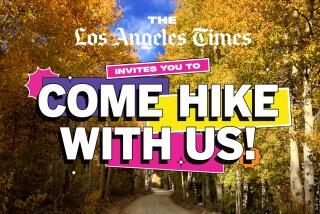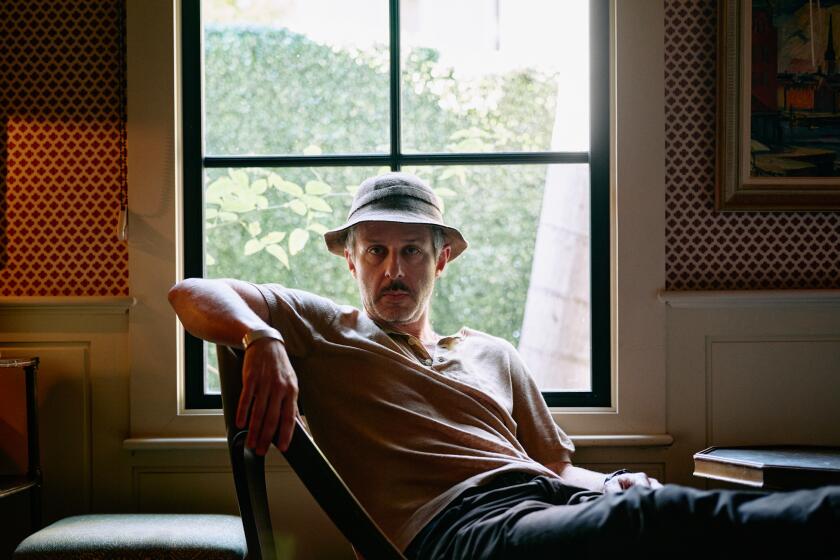A Walk Back Into Reel History
About 1,000 western and adventure movies were filmed at the Corriganville Movie Ranch from 1937 to 1965. Some Hollywood historians claim that this picturesque locale in the Simi Hills was the most extensively used film location outside a major studio.
Now the old spread where the Lone Ranger rode, the Fugitive fled and Lassie came home is a new park that offers hikers a chance to step back into film history.
Corriganville was founded by Raymond Bernard, who changed his name to Ray “Crash” Corrigan, the name of a character he played in “Undersea Kingdom,” a 1930s movie serial. Corrigan broke into the biz as a stuntman and as a body double for “Tarzan” (Johnny Weissmuller).
As the story goes, it was Clark Gable who piqued Corrigan’s interest in Simi Valley. The two actors met on the set of “Mutiny on the Bounty” in 1935. Gable took Corrigan quail hunting in the Simi Hills, and soon after Corrigan purchased 2,000 acres that he was certain would be an ideal western movie backdrop.
Among the more memorable westerns filmed in Corriganville were “Duel in the Sun,” “Streets of Laredo,” “Fort Apache” and “How the West Was Won.” Noted TV shows shot here included “Gunsmoke,” “Have Gun, Will Travel” and “The Cisco Kid.”
In 1948 Corriganville was opened to the public as a Wild West-flavored amusement park, complete with rodeo exhibitions and stagecoach rides. During the mid to late 1950s, Corriganville often drew 15,000 to 20,000 visitors on a busy Saturday or Sunday--attendance that sometimes exceeded that of Disneyland or Knott’s Berry Farm.
Corrigan bought the ranch for $11,000 in 1937 and sold it for $2.5 million in 1965 to entertainer Bob Hope. “Hopetown,” as it became known, hosted movie-making for only one year. Severe fires in 1971 and 1979 destroyed all of the sets, and Hope sold out in 1985 to developer Griffin Homes. The builder sold the heart of Corriganville to local parks authorities, and the 225-acre park opened last spring as part of the Rancho Simi Valley system.
Corriganville Park plays a dual role as nature preserve and nostalgia. A new, family-friendly, 20-stop interpretive trail explores the terrain’s natural and cinematic highlights. Between stops, even more plaques and signs delve deeper into this land’s movie history.
A far-from-family-friendly trail connects Corriganville with Rocky Peak and the rugged hills on the other side of the Ronald Reagan Freeway (California 118).
The curious hiker may wonder: “How do I cross the freeway?”
You don’t. You go under it via a concrete-walled tunnel.
The tunnel and trails north and south of the freeway form a “wildlife corridor” designed to allow animals to migrate across the Simi Hills without becoming road kill. The corridor is working: I glimpsed coyotes on both sides.
In its present state, the trail on the north side of the freeway is extremely overgrown with brush. Intrepid hikers should wear long pants and long sleeves and expect to be scratched and scraped by the chaparral that crowds the trail. The trail head, however, is in decent shape, so you’ll at least be able to stay on the right path.
Once you beat through the bush to meet Rocky Peak Road, you’ll find an excellent trail system that extends to Rocky Peak and other scenic destinations.
Directions to trail head: From the Ronald Reagan Freeway (118) in Simi Valley, exit on Kuehner Road and drive south a mile to Smith Road. Turn left and proceed a short distance to road’s end and plenty of parking in Corriganville Park.
The hike: From the east end of the parking lot, follow the dirt road east past some coast live oaks, and you’ll soon join the park’s signed nature trail. Your route parallels railroad tracks that seem to disappear up ahead into the mountains; the “disappearance” is actually a 1.5-mile-long tunnel connecting Simi Valley with Chatsworth.
Santa Susana Tunnel, completed in 1904, was regarded as quite an engineering feat. The nature trail soon leads to the site of Chinese Camp, where Chinese laborers stayed during construction of the tunnel and tracks.
At Sherwood Forest, the oaks featured in “Robin Hood” now shade an inviting picnic ground. Here the trail splits. Those wishing to continue the nature trail’s gentle exercise in nostalgia need only follow the numbered signs.
Hardier hikers bound for the Simi Hills back country will walk to the far end of the picnic area and a shade area, and join the unsigned trail leading northeast. As this path ascends it morphs into a crumbling asphalt road, then an Appian Way-like path of flat stones.
A short but steep climb brings you to the 118 Freeway and the mouth of the tunnel leading under it. Walk through the graffiti-marred tunnel and emerge to join a footpath that briefly heads west above and parallel to the freeway, then swings northeast.
What begins as mediocre trail turns from bad to worse as chemise and other trail-crowding chaparral hamper the hiker’s progress. Truly it’s an odd experience to be bushwhacking in such close proximity to a freeway. What seems like a very long mile of hiking brings you to a junction with Rocky Peak Fire Road.
Reward yourself by walking 100 yards south down the fire road to a bench and viewpoint. Rest up for the return trip as you enjoy a bird’s-eye view of Corriganville and Simi Valley.
Saner sojourners (those sticking with the nature trail) will depart Sherwood Forest and cross a bridge over the creek that cuts through Corriganville. Note the concrete pool created by movie makers, who filmed underwater scenes through portholes.
The path turns back west and soon passes the rocky hide-outs used by many a movie bad guy. Be sure to hike the 75-yard side trail to a cave featured in episodes of “The Fugitive” TV series, starring David Janssen. These environs were also the locale for that cult classic “Billy the Kid Vs. Dracula” with John Carradine.
The nature trail becomes just that again briefly, with ecological explanations about lichen and sandstone formations. For movie fans, the trail saves the best for last as it visits the site of a Corsican village built for “Vendetta,” a picture produced by Howard Hughes in 1950, and the site of the John Ford-directed 1948 western “Fort Apache,” starring John Wayne and Henry Fonda.
The path skirts the scant remains of Silvertown, Corriganville’s movie set town, then returns to the parking area.
(BEGIN TEXT OF INFOBOX / INFOGRAPHIC)
Corriganville Loop, Rocky Peak Connector Trails
WHERE: Corriganville Park, Simi Valley.
DISTANCE: Corriganville Park Loop is 2 miles round trip; to Rocky Peak Fire Road is 5 miles round trip with 600-foot elevation gain.
TERRAIN: Rocky hillsides’ oak groves.
HIGHLIGHTS: New interpretive trail explores once famous movie ranch.
DEGREE OF DIFFICULTY: Easy hiking in park; strenuous outing to Rocky Peak Fire Road.
PRECAUTIONS: Brush-overgrown trail outside park; watch for poison oak.
FOR MORE INFORMATION: Rancho Simi Recreation and Park District; tel. (805) 584-4400.
More to Read
Only good movies
Get the Indie Focus newsletter, Mark Olsen's weekly guide to the world of cinema.
You may occasionally receive promotional content from the Los Angeles Times.










